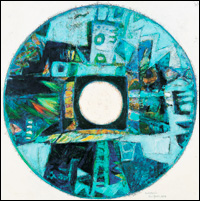 Living abroad, especially for a lengthy period, can demand great adjustments, and different people respond to such demands in different ways. Some grow to identify more strongly with the culture of their origin, while others throw themselves wholeheartedly into their adopted home.
Living abroad, especially for a lengthy period, can demand great adjustments, and different people respond to such demands in different ways. Some grow to identify more strongly with the culture of their origin, while others throw themselves wholeheartedly into their adopted home. The late artist Park Jae-kon (1937-1993) spent a great part of his adult life living and traveling in South America. As his art shows, Park was unafraid to immerse himself in the artistic tradition of his new environment and be influenced by South America's landscapes and traditional culture.
Having graduated from Seoul National University in 1960, Park left South Korea in 1972 with his wife and two daughters. He and his family settled in Argentina but the artist traveled greatly, making his way through the Amazon, the Andes and other regions. Park spent the rest of his life painting in South America, returning permanently to Korea just prior to his death.
Perhaps due to having lived abroad for so long, Park is not well known in his native country. The National Museum of Contemporary Art in Gwacheon, south of Seoul, is trying to change that with a retrospective of the artist, comprising over 100 paintings, drawings and prints. According to the museum, the exhibition is part of an ongoing attempt to bring attention to artists who may have heretofore slipped through the cracks of art history.
At first glance, there is little that is ``Korean'' about Park's artworks. Indeed, he seems to have fully and enthusiastically merged his artistic personality with his new surroundings. His abstract landscapes reflect the colors and light of the South American mountains, while his geometric abstractions seek inspiration from the continent's ancient civilizations.
 In particular, the expatriate artist was heavily influenced by the imagery of the Incans. Many of his paintings co-opt patterns, images and hieroglyphic iconography from the ancient culture. Sometimes, the artworks seem akin to archeological excavations, as if Park were recreating the ancient arts in his attempt to understand their mysteries.
In particular, the expatriate artist was heavily influenced by the imagery of the Incans. Many of his paintings co-opt patterns, images and hieroglyphic iconography from the ancient culture. Sometimes, the artworks seem akin to archeological excavations, as if Park were recreating the ancient arts in his attempt to understand their mysteries. However, Park's interest in these South American civilizations was not a purely academic one. Rather, he seems to have felt a deep philosophical and mystical connection, which he described in the writings included in the exhibition.
Park especially felt an affinity with the mandala, an important symbol in the ancient cultures. He said the mandala ``exists in each of our souls and lies in the sacred circle of humanity and the world.'' Park returned frequently to the mandala image, as well as its variations, throughout his life.
The Gwacheon exhibition is organized by theme, and foregoes a chronological ordering. Sections such as ``Exotic Landscapes'' and ``The Discovery of Patterns'' group paintings and drawings from different times of the artist's career together, but with a similar thematic focus.
The section titled ``Life-Roots'' is dominated by a series of colorful silkscreen prints that express Park's attachment to two disparate cultures: his adopted home and his country of birth. The prints utilize the colors and patterns of ancient Incan and Aztec art. The iconography in the prints, on the other hand, also borrows from traditional Korean patterns of birds, dragons and pillows.
``Misterio: Park Jae-kon'' is on display, free of charge, until March 1, 2009, at the National Museum of Contemporary Art.

